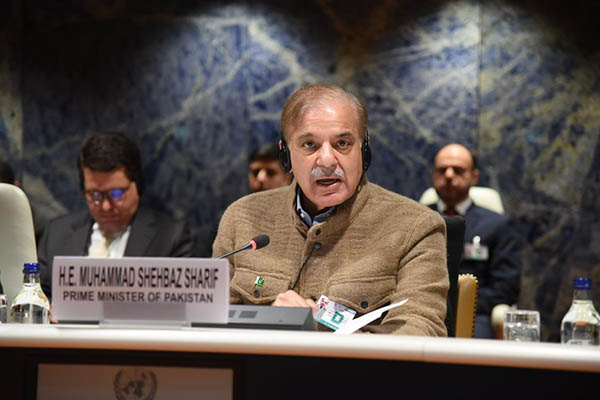
P.M. Shehbaz Sharif addresses Geneva donors’ conference. Photo courtesy PID
The global response to Pakistan’s appeal for help after last year’s devastating floods has been heartening. Already struggling with a precarious economy—with foreign exchange reserves barely sufficient to cover a month of imports and a stalled IMF program—Pakistan took a major hit from the floods, which killed over 1,700 people, left a third of the country underwater, cut annual growth by half, and caused about $32 billion in overall damages. The scale of the disaster has raised significant questions about the country’s ability to rehabilitate and reconstruct, even as investors worry about its ability to repay loans whose repayments are due in the coming weeks.
In a recent donors’ conference at Geneva, the World Bank pledged $1.69 billion to finance projects supporting people living in flood-hit areas of Sindh, while the Islamic Development Bank announced $4.2 billion in aid over the next three years. The European Union pledged €87 million (roughly $93 million) to strengthen “green inclusive growth and employable skills” in Pakistan, while Germany pledged €84 million to support its recovery efforts. French President Emmanuel Macron, attending the conference via video-link, said he would provide €10 million in emergency aid, and inject a further €360 million into the French development agency to help Pakistan rebuild and adapt to climate change. The USAID pledged an additional $100 million, while Malaysia pledged $200,000 for flood victims in Pakistan. Overall, of the $8 billion sought by the government of Prime Minister Shehbaz Sharif, various states and lending agencies pledged $9 billion to tackle what threatens to be the most intractable rehabilitation problem befalling a state already in economic and political distress.
The pledged funds are, however, only a start. Pakistan now faces a truly daunting task in utilizing them to repair the infrastructure damaged by the floods. Approximately 1.92 million houses were destroyed; 375 bridges damaged; and over 12,500 kilometers of roads washed away. Additionally, 3.6 million acres of crops were damaged, including 65 percent of Pakistan’s main food crops and 70 percent of its rice crops, as estimated by the International Rescue Committee. Coupled with substantial livestock losses is destruction of various stored commodities like wheat, vegetables, fertilizers, which spell trouble for the country’s food security and will likely boost inflation in the coming months. Pakistan is, understandably, happy to receive the pledges, but no amount of funding will be enough to cover the lives and property lost by flood affectees, many of who are still living without permanent shelter.
The floods have come and gone, but the political and social changes they will inflict are just beginning. Is Pakistan ready for a challenge it cannot yet even properly evaluate?
